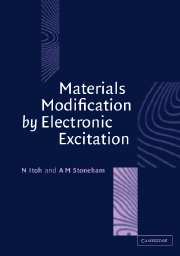Book contents
- Frontmatter
- Contents
- Preface
- 1 Concepts: Excitation, polarons and electronic structure
- 2 Energy deposition and redistribution in solids
- 3 Electron–lattice coupling and its consequences
- 4 Self-trapping
- 5 Local lattice modification by electronic excitation of halides
- 6 Local lattice modification by electronic excitation of crystalline insulating oxides
- 7 Local lattice modification of semiconductors by electronic excitation
- 8 Local lattice modification of amorphous materials by electronic excitation
- 9 Atomic emission and surface modification
- 10 Interface reactions induced by electronic excitation
- 11 High excitation intensities
- 12 Applications of materials modification by excitation
- References
- Index
10 - Interface reactions induced by electronic excitation
Published online by Cambridge University Press: 11 August 2009
- Frontmatter
- Contents
- Preface
- 1 Concepts: Excitation, polarons and electronic structure
- 2 Energy deposition and redistribution in solids
- 3 Electron–lattice coupling and its consequences
- 4 Self-trapping
- 5 Local lattice modification by electronic excitation of halides
- 6 Local lattice modification by electronic excitation of crystalline insulating oxides
- 7 Local lattice modification of semiconductors by electronic excitation
- 8 Local lattice modification of amorphous materials by electronic excitation
- 9 Atomic emission and surface modification
- 10 Interface reactions induced by electronic excitation
- 11 High excitation intensities
- 12 Applications of materials modification by excitation
- References
- Index
Summary
Interfaces control a variety of technological applications of materials, and their characterisation, synthesis, and modification determine how well these interfaces perform. Interfaces have several roles of direct interest to us. First, interfaces provide sites where electronic excitation energy can be localised. This makes it possible to modify interfaces without affecting bulk properties. Secondly, at an interface atoms from the materials on both sides of the interface meet. Bond rearrangements at the interface can affect microscopic structures. Thirdly, interfaces include a variety of defects which do not exist in the bulk. The structures of these defects are also susceptible to electronic excitation. Some of these defects are associated with mismatch in lattice parameter between the media on either side of the interface. Fourthly, a wealth of new interfaces is being created by methods such as ion-beam sputtering. These include tens or hundreds of alternating layers, for example of Si/SiO2, A12O3/SiO2, Ta2O5/SiO2, TiO2/SiO2, HfO2/SiO2 or MgF2/SiO2 (see, e.g., Howe (1999), or Reichling et al. (1998a)). Reichling et al. suggest that most induced laser damage occurs at the substrate/film boundary. These multilayers can be crystalline or amorphous, and can be constructed so that layer thicknesses match a particular wavelength (typically, λ/4 layers with a λ/2 cap might be used). In some cases, self-organisation has been seen. Since these systems are used in laser applications, their performance under excitation is important. Finally, we note that interfaces can evolve in interesting ways when the interfacial free energy is lowered by mixing.
- Type
- Chapter
- Information
- Materials Modification by Electronic Excitation , pp. 379 - 406Publisher: Cambridge University PressPrint publication year: 2000



